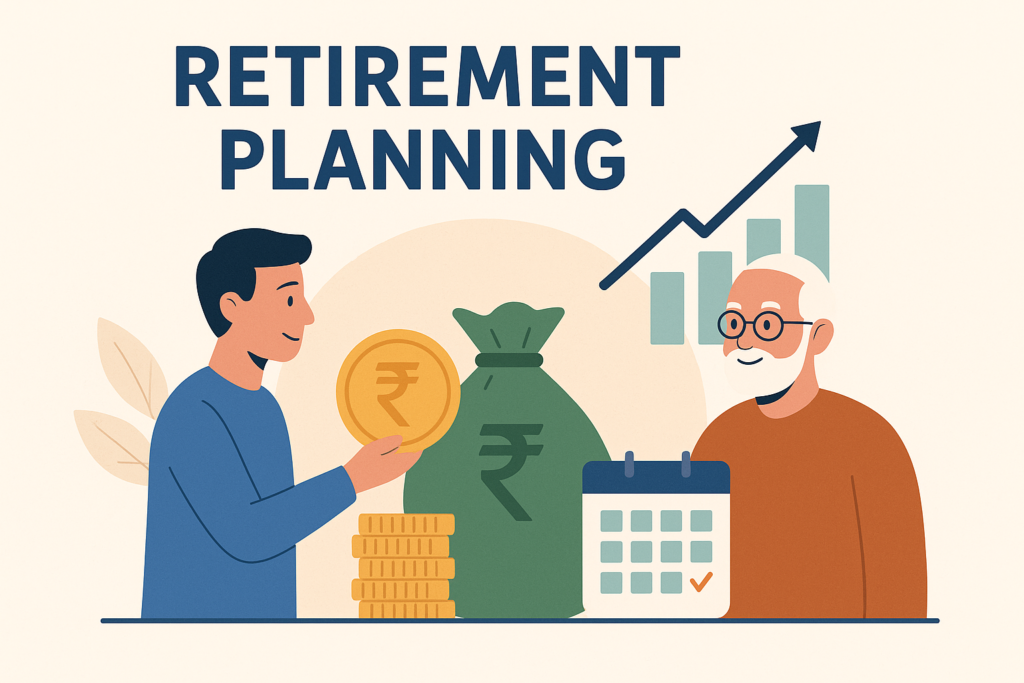Retirement may feel like a distant milestone when you are in your 20s or 30s, but time passes faster than we think. The earlier you start planning, the easier it becomes to build wealth, ensure financial freedom, and enjoy a stress-free retirement. Retirement planning is not only about saving money but also about making smart investment choices, controlling lifestyle inflation, and taking advantage of compounding.
This guide covers smart ways to build wealth early, practical strategies for different age groups, tax-saving opportunities, and common mistakes to avoid.
- Why Retirement Planning Matters
- Step 1: Start Early – The Power of Compounding
- Step 2: Set Clear Retirement Goals
- Step 3: Choose the Right Investment Vehicles
- Step 4: Create Multiple Income Streams
- Step 5: Insurance & Risk Protection
- Step 6: Tax Planning for Retirement
- Step 7: Avoid Lifestyle Inflation
- Step 8: Review & Rebalance Regularly
- Retirement Planning by Age
- Common Retirement Planning Mistakes to Avoid
- FAQs on Retirement Planning
Why Retirement Planning Matters
- Rising Life Expectancy: With better healthcare, many of us will live longer than our parents did. You may spend 20–30 years in retirement.
- Inflation: The cost of living doubles roughly every 10–12 years. A ₹50,000 monthly expense today could cost over ₹2 lakh in retirement.
- No Guarantee of Pensions: Unlike previous generations, most private-sector jobs don’t provide pensions.
- Financial Independence: Proper planning helps you maintain your lifestyle without depending on children or relatives.
Step 1: Start Early – The Power of Compounding
The biggest secret to retirement planning is starting early. Even small amounts invested consistently can grow into significant wealth.
Example of Compounding
- If you invest ₹5,000/month at age 25 (10% annual return), by age 60 you will have ₹1.9 crore.
- If you start at 35, the same investment grows to only ₹65 lakh.
- Waiting till 45 reduces it further to ₹21 lakh.
👉 Lesson: Time matters more than money in wealth building.
Step 2: Set Clear Retirement Goals
Before investing, ask yourself:
- At what age do I want to retire?
- What lifestyle do I want after retirement (travel, hobbies, healthcare needs)?
- How much will I need monthly in retirement?
- Do I want to leave wealth for children or charities?
Rule of Thumb
You need 20–25 times your annual expenses as a retirement corpus.
- Example: If you spend ₹6 lakh/year, your retirement goal should be at least ₹1.2–1.5 crore (without inflation). Adjusting for inflation, it could be ₹3–4 crore.
Step 3: Choose the Right Investment Vehicles
1. Employee Provident Fund (EPF) & Public Provident Fund (PPF)
- Safe, government-backed, and offer decent interest (7–8%).
- EPF is deducted automatically if you are salaried.
- PPF is open for everyone and has a 15-year lock-in, extendable in blocks of 5 years.
2. National Pension System (NPS)
- Flexible and tax-efficient retirement scheme.
- You can invest in equity, corporate bonds, and government securities.
- Partial withdrawal allowed for emergencies.
- Extra tax benefit under Section 80CCD(1B) – up to ₹50,000.
3. Mutual Funds (Especially SIPs in Equity Funds)
- Long-term equity investments give higher returns (10–15%).
- SIPs (Systematic Investment Plans) are great for disciplined saving.
- Use index funds or retirement-focused mutual funds.
4. Stocks & Equity Investing
- Higher risk but also higher potential growth.
- Ideal for young investors with long horizons.
- Focus on diversified portfolios or ETFs.
5. Real Estate
- Can provide rental income and appreciation.
- Don’t rely only on property — combine with financial assets for liquidity.
6. Gold & Digital Gold
- Good hedge against inflation.
- Avoid putting more than 5–10% of your portfolio.
7. Fixed Deposits & Bonds
- Lower risk but limited returns.
- Suitable for the conservative portion of your retirement portfolio.
Step 4: Create Multiple Income Streams
Relying only on one source of income is risky. Build diversified income streams:
- Salary + side hustles (freelancing, consulting).
- Rental income from real estate.
- Dividend income from stocks.
- Royalties (books, courses, intellectual property).
Step 5: Insurance & Risk Protection
Retirement planning is not just about wealth creation—it’s also about wealth protection.
- Health Insurance: A must, as medical expenses rise with age.
- Life Insurance (Term Plan): Protects your family if something happens to you early.
- Critical Illness Cover: Safeguards against high medical bills.
Step 6: Tax Planning for Retirement
Taxes can eat into your retirement savings if not planned well.
- Use Section 80C (₹1.5 lakh deduction for PPF, ELSS, EPF).
- NPS extra deduction under Section 80CCD(1B).
- Senior citizen benefits: Higher tax exemption limits after 60.
- Invest in tax-efficient products like ELSS, PPF, and NPS.
Step 7: Avoid Lifestyle Inflation
As income grows, people tend to spend more on luxuries. Control this urge.
- Increase savings rate whenever you get a raise.
- Follow the 50-30-20 rule: 50% needs, 30% wants, 20% savings.
- Aim to save 30–40% of income for early financial independence.
Step 8: Review & Rebalance Regularly
Your financial situation and market conditions will change.
- Review investments every 6–12 months.
- Rebalance portfolio (equity vs debt) as you age.
- Age 20–35: 70–80% equity, 20–30% debt.
- Age 35–50: 60% equity, 40% debt.
- Age 50–60: 30–40% equity, 60–70% debt.
Retirement Planning by Age
In Your 20s
- Start SIPs, however small.
- Focus on equity and long-term assets.
- Build emergency fund (6–12 months’ expenses).
In Your 30s
- Increase investments as income rises.
- Buy adequate insurance.
- Begin serious tax planning.
In Your 40s
- Peak earning years – maximize investments.
- Pay off major debts (home loan, car loan).
- Rebalance portfolio toward safer assets.
In Your 50s
- Focus on capital preservation.
- Build retirement income streams.
- Avoid high-risk bets.
Common Retirement Planning Mistakes to Avoid
- Starting too late – biggest wealth destroyer.
- Overdependence on one asset (like property).
- Ignoring inflation – your money loses value.
- Not having insurance – one health crisis can wipe out savings.
- Dipping into retirement savings early – treat it as untouchable.
FAQs on Retirement Planning
1. What is the best age to start retirement planning?
The best time is in your 20s. The earlier you start, the less you need to save monthly.
2. How much should I save for retirement?
Experts suggest saving 15–20% of your income. If you start late, increase it to 30–40%.
3. Which is better for retirement: mutual funds or PPF?
Both serve different purposes. PPF is safe and stable, while mutual funds give higher growth. A mix works best.
4. Can I retire early in India?
Yes, with FIRE (Financial Independence, Retire Early) strategy. It requires aggressive saving and investing 50–60% of income.
5. What if I start retirement planning at 40?
It’s not too late. Increase your savings percentage, cut expenses, and focus on high-return investments.



